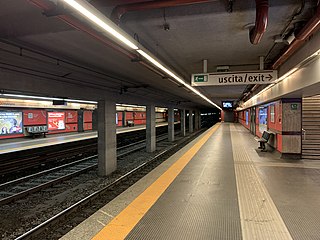
The Capitoline Museums are a group of art and archaeological museums in Piazza del Campidoglio, on top of the Capitoline Hill in Rome, Italy. The historic seats of the museums are Palazzo dei Conservatori and Palazzo Nuovo, facing on the central trapezoidal piazza in a plan conceived by Michelangelo in 1536 and executed over a period of more than 400 years.

Monti is the 1st rione of Rome, identified by the initials R. I, located in Municipio I. The name literally means "mountains" in Italian and comes from the fact that the Esquiline, the Viminal Hills, and parts of the Quirinal and the Caelian Hills belonged to this rione: currently, however, the Esquiline Hill belongs to the rione Esquilino.

Campitelli is the 10th rione of Rome, identified by the initials R. X, and is located in the Municipio I.

Celio is the 19th rione of Rome, identified by the initials R. XIX, and is located within the Municipio I.

The Palazzo Venezia or Palazzo Barbo, formerly Palace of St. Mark, is a palazzo (palace) in central Rome, Italy, just north of the Capitoline Hill. The original structure of this great architectural complex consisted of a modest medieval house intended as the residence of the cardinals appointed to the church of San Marco. In 1469 it became a residential papal palace, having undergone a massive extension, and in 1564, Pope Pius IV, to win the sympathies of the Republic of Venice, gave the mansion to the Venetian embassy to Rome on the terms that part of the building would be kept as a residence for the cardinals, the Apartment Cibo, and that the republic would provide for the building's maintenance and future restoration. The palace faces Piazza Venezia and Via del Plebiscito. It currently houses the National Museum of the Palazzo Venezia.

Piazza Venezia is a central hub of Rome, Italy, in which several thoroughfares intersect, including the Via dei Fori Imperiali and the Via del Corso. It takes its name from the Palazzo Venezia, built by the Venetian Cardinal, Pietro Barbo alongside the church of Saint Mark, the patron saint of Venice. The Palazzo Venezia served as the embassy of the Republic of Venice in Rome.

Ottaviano–San Pietro–Musei Vaticani is a station on Line A of the Rome Metro.

Barberini–Fontana di Trevi is an underground station on Line A of the Rome Metro, inaugurated in 1980 and situated under Piazza Barberini in Trevi. Originally, the station was simply named Barberini, and the name was extended in 2000.

The Basilica of Saints John and Paul on the Caelian Hill is an ancient basilica church in Rome, located on the Caelian Hill. It was originally built in 398.

Line C is a Rome Metro line which runs from Monte Compatri-Pantano in the eastern suburbs of Rome, in Italy, to San Giovanni near the city centre, where it meets Line A. It is the third metro line to be built in the city and the first to be fully automated.

Cavour is a station on Line B of the Rome Metro, opened on 10 February 1955. It is located on via Cavour, in the Monti rione of Rome, midway between Santa Maria Maggiore and via dei Fori Imperiali.

EUR Magliana is a railway station in Rome served by the Metro line B and the Ferrovia Roma-Lido in the EUR or Europa district of Rome. It was opened in 1924 as a Roma-Lido station for the Esposizione Universale Roma as Magliana. It was later renamed Magliana Ostiense, then Magliana again and finally its present name.

The current tram system in Rome, Italy, is a leftover from what once was the largest tram system in Italy. With its fragmented structure, it does not currently function as a backbone of the city's public transport. The system is owned and operated by Azienda Tranvie e Autobus del Comune di Roma.

Francesco Mancini was an Italian painter whose works are known between 1719 and 1756. He was the pupil of Carlo Cignani.
The culture of Rome in Italy refers to the arts, high culture, language, religion, politics, libraries, cuisine, architecture and fashion in Rome, Italy. Rome was supposedly founded in 753 BC and ever since has been the capital of the Roman Empire, one of the main centres of Christianity, the home of the Roman Catholic Church and the seat of the Italian Republic. Due to its historical and social importance, Rome has been nicknamed the Caput Mundi, or "capital of the world".

Municipio I is an administrative subdivision of the municipality of Rome, encompassing the centre of the city.

ATAC S.p.A. is an Italian publicly owned company running most of the local public transportation services, paid parking and incentive parking lots in Rome. More specifically, the company handles, on behalf of Roma Capitale Authority, the entire tramway, trolleybus network and metro lines, as well as most of the bus lines in the city. It also operates, on behalf of the Administrative Region of Lazio, three railways: Roma-Civita Castellana-Viterbo, Roma-Giardinetti and Roma-Lido. ATAC S.p.A., with its 2,200-kilometer-wide public transport network, its over 8,500 busses and 70,000 parking stalls, is currently one of the biggest public transportation companies in Europe and the largest in Italy.

The following outline is provided as an overview of and topical guide to Rome:




















